|
1915 THROUGH 1952 In 1953, the Standard Democrat published a series of articles, prepared by Carl F. Treichel, long-time teacher and coach at Burlington high school, on the history of football at the school. The series covered the history through 1952, the last year that Harry "Dinty" Moore coached football at BHS. The articles were accompanied by photos of several teams. Those photos, although of poor quality, are included with this series of articles, as are other photos from the collection of the Burlington Historical Society. Standard Democrat, September 10, 1953 Colorful History of Football at Burlington High School Told; First Season Was Rough Editor=s Note: This is the first in a series on the football history of Burlington high school, prepared through the efforts of Carl Treichel. Back in the days when one AKaiser Bill@ was trying to run the world, when Chief Beller was running our town almost singlehandedly, and our dear ladies thought they could run our country better if they only had the right to vote, a few boys who were not satisfied with the way Burlington high school athletics were run, ambled down to Supt. Witter=s office and asked his permission to start a football team. This was in 1915. Mr Witter consented, providing the boys raised their own funds needed to buy equipment. Four teams of two boys each solicited the business places about town and collected around $80 (about as much as two football uniforms cost today) (Historical Society note: 1953), which fund was enough to buy pants and helmets only. Football shoes were provided by the boys themselves. They merely took an old pair of high cut shoes such as were commonly worn in those days and had the cobbler nail leather cleats onto the soles and heels. The boys also provided their own socks (stockings) and shirts or jerseys, and in place of shoulder pads the lads had their mothers sew padding into the inside of the jerseys. The squad was made up of about 25 candidates, which number dwindled to around 15. There were seldom two squads present, so the coach shifted one side of the line around in front of the other for scrimmage. Harry S. Young was the coach. Carl Beller was the first captain, and Ed Jahns was manager. Ed played center and was later replaced by APete@ Newbury as manager. Pete, it is told, presented the cheerleaders with a box of candy at the end of the season for their fine work at the games. Mr. Young deserved credit for providing much of the drive and organization to get the game started. Practice was held on the Cooper school Aflat,@ which at that time was covered largely with a surface layer of gravel and partly submerged boulders. At the beginning of each season Mr. Young organized a crew of boys with picks, shovels, and wheelbarrows, to remove the worst and largest stones. The team had only one ball and by the end of the season this ball was almost round and the ends were worn through. The games were played at ACentral park,@ which was a hayfield where the Elmhurst addition now is located. (Historical Society note: The Elmhurst addition, formerly the Charles Ball farm, is on the north side of W. State Street between Elmwood Avenue and N. Kendrick Avenue.) There is no record of any games played in 1915, but in the fall of 1916 a full schedule was arranged. To start the season properly, Coach Young came up with the typical remark that the prospects were not bright because Athough there was plenty of material, there was no interest in football.@ Nonetheless, the boys limed the field and erected the goal posts and come Saturday they played the first game. The first game was against Mukwonago. Burlington lost 24 to 6, Beller making the touchdown. By way of sports reporting we read in the AHigh School Hits@ of The Standard Democrat the following account of the game, written by Elmer Baumgart: Schemmer and Wehmhoff tore big holes in their opponents line. AWolf@ Beller played a stellar game at fullback making large gains around end. Ed. Jahns at center more than held his own with his more experienced opponent. AFran@ Plate at tackle was a stone wall, for no one went through his position. The ends, ARed@ Newbury and APinky@ Groff, had all they could do catching passes. AChick@ Evans, AWizard@ Coleman and ASpeed King@ Dettman formed good interference, and last but not least, Tony Itzin was a stone wall, which no one could have attempted to break through. ASpeed King,@ it is also noted in the AHits@ fell asleep in class the following week and fell off his chair. Strenuous practice no doubt. But he made up for this failure by winning the weekly literary contest the week following. The second game was lost to Northwestern Military Academy by a 71 to 0 score, which prompted Mr. Young to come up with the sage remark, Athat there would be some new faces in the lineup come Saturday.@ The remark seems to have brought results because the following Saturday the boys went forth and beat Delavan to the tune of 25 to 6, whereupon Mr. Young immediately challenged any team in southern Wisconsin for the championship of southern Wisconsin. The season ended with losses to Lake Geneva, 12 to 0, and West Allis, 37 to 13, which, considering the odds the boys were working against, was a remarkable showing made by the first Burlington high school football team. By the following fall the country had entered the war. A schedule was arranged and several games were played, but lack of candidates, equipment, and enthusiasm caused Mr. Young to cancel the last two games and end the season. Football was abandoned entirely in 1918 and revived after the end of the war in the fall of 1919. When football was revived again it was largely through the efforts and determination of the remarkable and colorful character of Harry S. Young, who though he had lost the use of one leg through polio, never let his handicap discourage him. He defied all the laws of physics by walking with only one crutch and one good leg. He could kick a football farther than most boys in school. Historical Society note: The article was accompanied by a photo of the 1916 team, with the following caption: Here=s the tough BHS team of 1916. Top row: Pete Newbury, May, Healy, Evans, Schemmer. Middle row: Groff, Young (coach), Wehmhoff, Bushman, Coleman. Bottom row: Don Newbury, Plate, Jahns, Beller (captain), and Dettman.
Standard Democrat, September 24, 1953 Many Incidents on the B. H. S. Gridiron Made the Previous Football History of Our Public High School Very Colorful (Editor=s Note: We continue with the history of Burlington high school=s football teams. This chapter begins in 1919 and ends in 1925. Many incidents are revealed. The article was compiled by one of the first coaches at the high school.) The game of football was resumed at BHS in the fall of 1919, after the first world war in much the same manner as it began in 1916, with all new equipment and all new faces in the line up. The first game was played at Racine. It was a disastrous day B Burlington lost, 54 to 0. One of our players was left behind in a Racine hospital with a broken ankle, and both coming and going we encountered difficulties in the form of punctures, blowouts, and no end of near accidents. Some of the boys ate their supper at about 11 o=clock that evening when the last car limped back into town. The season could hardly be called a success. We lost every game but one, and that one was not a victory. It was tie game with Mukwonago, and it was pretty much of a personal triumph for one Hugh Sutton, who could be called one of the all-time greats of Burlington=s athletic history. Toward the end of the game with the score 7 to 0 in Mukwonago=s favor, Sutton plunged and ran thru and around the Mukwonago line for about 60 yards, and then flipped a pay off pass to AWally@ Hastings, who with the aid of a block from his cousin, Ray Haas, crossed the goal line standing. Poor Season The following year conditions were even worse. Before the first game was played six regular players were on the sidelines. No bear story ever matched this one. One player had a broken collar bone, another a dislocated elbow, the third a badly sprained wrist, the fourth could not pass the doctor=s inspection, and the parents of two others refused to allow their sons to play. No wonder we won nary a game that year. Not until 1921 did Burlington=s star begin to rise. That year we won one game against West Allis, tied Delavan and Mukwonago; and held Waukesha to a 12 to 0 score. The worst defeat was from Elkhorn, 19 to 0. The 1922 season was even more successful. Burlington won two and tied one, and played a strong Waukesha team to a standstill, losing only in the last quarter by a 6 to 2 score. This marked the first year in which Burlington scored more points than their opponents. The team of 1923 can rightfully lay claim to the title of the first championship team of BHS, losing only one game to a team they had beaten earlier in the season, and the three teams of 1922, 1923, and 1924 can be called the most colorful in Burlington high school history. Many are the stories told about the players and games of those days. There was for example the time when quarterback Kenneth Kruckman, after fumbling passes from AHans@ McCarthy in the end zone all afternoon, finally ran the ball to the middle of the field in front of the goal posts and ordered AHans@ to dropkick it over. AHans@ did. Final score, Burlington 3, Antioch 0. In the Hole Carroll Bushman tells about standing in a deep furrow in Brook=s pasture while centering the ball. The opposing Waukesha center jumped clear over his back and threw our quarterback for a loss. Then there is the story which might illustrate why coaches get old before their years. It concerns a quarterback who played in 1924 and called a scoring play. The play was an unbalanced line formation with two powerful tackles playing together to clear the way for a plunging fullback. The quarterback was told to use the play when on the 20 yard line B i.e., Geneva=s 20 yard line. Geneva kicked off and our receiver brought the ball out to our own 20 yard line. You can guess what happened, the quarterback was on a 20 yard line. Well, the play was good for a five yard gain every time he called it and he called it every time. It gained 80 yards and a touchdown, but after that it was a Adead duck@ and so were the tackles and fullback. Later in the game Geneva managed to carry the ball to our five yard line. Bullock, Geneva=s star fullback, came around end and collided with the shoulder of one Rudy Spieker, now (1953) Racine county sheriff. The impact jolted Mr. Bullock to the degree that the ball floated out of his hands into the arms of Kenneth Gardner. AKen@ was so surprised he did not know what to do, but Ralph Yopp reminded him that the goal line lies Athat-a-way,@ whereupon Kenny ran 95 years to a touchdown. Final score, BHS 14, Geneva 0. To those of you who are interested in football strategy, this story might be interesting. Elkhorn at that time had for a coach, an Indian named Chief Look-A-Round, who claimed to have played on the same team with the great Jim Thorpe. This Indian coached the Warner system and year in and year out he brought along some magnificent teams with fast, hard running backs and plenty of interference in front of the ball carrier. He trained them by running them up and down three flights of stairs in full uniform 20 times per day. In football it never pays to belittle your opponent. One afternoon we played Racine College. The Racine players seeing us come out of the locker room looked upon us with a critical eye. We did not look right. One of their players remarked that they had not come all the way from Racine to play our second team, and would we please bring on the first team. The final score was BHS 19, Racine College 13. Another instance when we played Marquette high of Milwaukee, Marquette scored a touchdown in the first five plays, which prompted one big Marquette lineman to remark, ALet=s run up a score on these hicks.@ Final score BHS 7, Marquette 6. Coach is Wrong Sometimes in football the coach can be wrong. The team of 1922, for instance, came to the coach with a play of their own which they wanted to try. The coach gave it a look and told them to forget it; it would not gain an inch. But the boys tried it anyway. It gained 15 yards. In the fall of 1923, Burlington had a pair of powerful tackles who were coached to play close to center on defense and charge out, while the guards and ends were to wait on the line of scrimmage. This unorthodox style of defense worked so successfully that the Elkhorn interference never really got started and was repeatedly Asmeared@ behind the line. The ball carrier when he got to the line of scrimmage was usually running alone to be picked off by the guards and ends. Elkhorn that year never scored a touchdown and the final score was BHS 20, Elkhorn 0. We learned football from the Chief but we were also able to teach him one or two tricks. A new era in football began in 1925. Burlington moved to a new building and a new coach took over. Historical Society note: The article was accompanied by a photo with the headline ABurlington High=s First Championship Team (1923)@ and the following caption: Bottom row, from left: Harry Wien, end; Vic Woeste, tackle; Ralph Uebele, guard; Harold Koch, center; Ray Leemkuil, guard; Rudolph Spieker, tackle; and Irving Wien, end. Top row: C. F. Treichel, coach; Franklin Wald, sub; Art Ebbers, right half; Ralph Yopp, fullback; Stanley Kelly, quarterback; Jim Hill, sub; Frank Standfield, left half; and Lloyd Fraser, sub.
Standard Democrat, October 8, 1953 During the Early Thirties Burlington High School Dominated the Football Leagues When Harry Moore arrived in Burlington in 1925, he faced the same problem that has confronted every coach at Burlington high school before his time and since. He had to start from scratch. Whatever is needed to put together a winning football team just simply was not to be found. For about five years our football fortunes were anything but sensational. Some interesting football was played during these years, however. In a game with Walworth, ASkip@ Krakofsky broke into the open and was headed for a game winning touchdown when he stepped into a gopher hole. After he stopped rolling, Walworth players had caught up with his progress. In 1926, in a game with Lake Geneva the score at the first half was 0 to 0. During the second half AHap Beix and Co.@ ran over Geneva for 11 touchdowns and 74 points. Question: What did Dinty tell the boys between halves that set the team on fire, and why didn't the Geneva coach tell his players the same thing? It was in the year 1930 that Burlington began a football era such as was never seen before, and it likely won=t see again. It was between the years of 1930 and 1936 that Coach Dinty Moore put together a series of teams that could warm the heart of any football fan. For seven years these Burlington teams rolled over any and all opponents and ran up the amazing record of 989 points to their opponents= 177. Let=s take a look at the record. In 1930 Burlington lost one game to Delavan, 6 to 0, tied one, and with the help of Johnny May=s running and a fine blocking team ran up a total of 89 points to the opponents 25. In 1931 a team with very much the same combination of players amassed a total of 224 points to their opponents 32; losing only to a powerful Elkhorn team 26-14, and clobbering Whitewater 85 to 0. This was the year when Johnny May ran for 20 touchdowns. In 1932, Dinty=s boys won an undisputed championship, winning all their games and amassing a total score of 175 points to their opponents 13. Only two teams could score on Burlington. It was the year when the amazing Robert O=Neill put on the show. In 1933 Burlington missed a championship by 3 points in spite of the fact that we lost 2 games and tied one. Lake Geneva beat us, 7 to 6; Whitewater beat us, 2 to 0; and the score at Elkhorn was 0 to 0. All the same, Burlington scored 66 points to 23 for the opposition. The year 1934 was a poor one comparatively. In that year our boys won 3 and lost 3, and tied one. It was the only year in the seven that Burlington was outclassed, 34 to 45. Then came the championship team of 1935. The line was a coach=s dream and a quartet of hard-running, hard-blocking backs ran all of the opposition into the ground to the tune of 210 to 6. Only Shorewood high school was able to score on Burlington. This team could lay claim to the title of the greatest all time team, but there are others who would vigorously dispute their claim. One peculiarity of the team is that it produced no brilliant star. The 1936 team lost the championship by one point, losing to Geneva, 7 to 6. There point total was 191 to 33. But boys do not stay in school forever. Graduation took its toll, and a brilliant era came to an end. In the years that followed Burlington lost and won an average number of games. Never again did our teams have to face the fearful odds that were faced by the teams of the early and late twenties. Nonetheless there followed years when a coach might well wonder B what does it take to put together a championship team? Historical Society note: The article was accompanied by two photos. The first, titled AWhen Johnny May Ran,@ was of the 1931 team with the caption reading:
The above picture (the same picture from the Nov. 20, 1931, Standard Democrat is at the left) includes most of the players of the 1930, 1931, and 1932 teams. Missing are Elmer AAmy@ Rubach, Jerome Peters, and Captain Eddie Koch. Peters and Rubach also played on the championship 1932 team as did Alex Rose, Wilmot Zerneke, and Francis Itzin. A picture of the 1932 team was not available. The 1931 squad, top row, left to right: Robert Prailes, Les Seno, Carl Martin, Joe Weyrough, Willis Reineman, Verdy Langdon, Robert Kruckman, and Paul Mueller. Middle row: Robert O=Neill, Les Hoganson, Lloyd Schmaling, Wilbert Burmeister, Ralph Larson, Bob Beix, Ken Howe, Wes Jaquith, and Chuck Beaumont. Bottom row: Chuck Wallis, Richard Beix, Don Prailes, Anthony Weiler, John Weiler, Coach Harry Moore, John May, Abe Itzin, John Reynolds, and Dave Dudley. The second photo was titled A1935 Championship Team@ and had the following caption:
Here is the great BHS championship football team of 1935. This team scored 210 points to their opponents 6. They beat Park, 26 to 0; Whitewater, 53 to 0; Shorewood, 21 to 6; Delavan, 19 to 0; Walworth, 45 to 0; Lake Geneva, 21 to 0; and Elkhorn, 25 to 0. Top row, left to right: Dick Summers, Jack Brenton, Robert Sharp, Malcolm Cook, Paul Syring, Jack Atherton, Dave Badenoch, Henry Barry, Bob Sapp, and Coach Harry Moore. Middle row: Herb Rossmiller, Bill Rein, Howard Larson, Ray Langdon, Len Bublitz, and Len Bucholtz. Bottom row: Harold Peters, Norb Ebbers, Jerry Augusten, Neil Summers, Don Giannini, Charles Weiler, and Harold Brenton.
Standard Democrat, November 5, 1953 History of Burlington High School=s Football Team Covers All Embarrassment After Last Friday Although Burlington high school=s record between 1937 and 1950 was not as brilliant as in the early thirties, it was nevertheless far above average. During all this time, Burlington seldom ended in the second division of the league. Between 1938 and 1950 Burlington won four championships and finished second four times. Let us look at the record. In 1938 BHS lost only one game. It was the year Bob Barry ran all over the place. Elkhorn was defeated that year, 74-6. In 1939 we won two, lost one, tied one. In 1941 we won two, lost one, tied one. Planned Ahead In 1943 and 1944 Burlington won the undisputed championship of the league, losing only to Janesville. One play in the 1944 season is worthy of note. The team to beat that year was Elkhorn. Rumor had it that Elkhorn was going to Aget@ Jack Rein and that he would not last over three plays. Jack predicted he would run for a touchdown the first time he carried the ball B and he did. It was not, however, due entirely to Jack=s brilliance. The play had been rehearsed all week and much strategy went into its execution. Jack had plenty of help, nevertheless he was a brilliant runner and ranks with the top halfbacks of all time. In 1945 BHS was defeated only once. In 1946 we likewise lost only one game. This was the year the SWANI (Southern Wisconsin and Northern Illinois) conference was formed and also the year lights were installed on our football field. Championship Team In 1947 Burlington won a championship by winning six games and losing one to Elkhorn, 8 to 7. Burlington scored 158 points that year to 21 for our opponents. The championship was won at the end of the season when ASam@ Reuschlein and his crew outsmarted a highly favored Harvard team at Harvard by two touchdowns to one. In 1948 the conference race ended in a three-way tie for first place, with Burlington, Lake Geneva, and Marengo in first place. Both of these teams defeated Burlington but a bad pass from center deprived us of undisputed first place. In 1950 Burlington won five, lost one and tied one. The tie game moved us from first place to third. To add to the irony of it, the team had three chances to make a point after touchdown to break that tie and missed all three. Poor Lake Geneva One unusual fact about this season must be noted. Geneva lost seven conference games, won none and ended in last place. During the years 1937, 1940, 1942, and 1949 Burlington broke even in conference play. ADinty@ Moore=s coaching career came to a close in 1952 when injuries and polio brought the season to an early end. During twenty-five years of coaching he won eight conference championships and ended in second place probably as many times. His teams always played brilliant offensive football. In the number of games won and lost, only Geneva has a better record. Following is the record of games won and lost, with the four prominent members of the league: BHS vs. Geneva . . . . . . . won 11, lost 12, tied 1 BHS vs. Delavan . . . . . . won 16, lost 8, tied 1 BHS vs. Elkhorn . . . . . . won 15, lost 6, tied 5 BHS vs. Whitewater . . . won 17, lost 8, tied 0 And now a new coach (Robert Belden) takes over and probably it is the irony of fate that he must begin like every coach before him B at the bottom only to build a new team and a new record. In this he has our complete support and best wishes. Historical Society note: The article was accompanied by two photos. The caption on the first was:
Here is Burlington high school=s championship team of 1941. Bottom row, left to right: Coach Dinty Moore, Clayton Fell, captain; Ronald Shepston, Jim Hewitt, Wally Robers, Bud Weygand, Bob Haas, ACorky@ Ficken, Tony Zwirgzdas, Wendell Richmond, and Jack Rein, captain. Top row: Bob Fell, Albert Welke, Dave Shenkenberg, Jim Hoffman, Eugene Wanat, Eddie Shenkenberg, Lester Badenoch and Clark Willich, student managers; between them, Douglas Beasecker, Art Gores, Johnny Brown, Ken Remer, Rich Vos, Vance Kloster, Leroy Robers, and Dick Warner.
The caption on the second photo was:
Here are
the SWANI conference champs of 1947. They won six games and lost one, with
their hard-fighting team. A different BHS type of player sits on the bench
today.
Standard Democrat, November 19, 1953 Who Were the Greatest Football Stars Produced at B. H. S. Through the Years? This is the last of a series of articles on the history of football at Burlington high school. The information was compiled by Carl Treichel, who has always shown a great interest in the sports history of this school. From these articles the reader has learned of the greatness that Burlington high school has registered through the years. They have had one of the finest records in this section of the state. Many times we have been asked who in our opinion was the greatest player who ever played for Burlington high school. Though we are not foolish enough to pick an all-time school football team, there are nevertheless, players whose records were outstanding and whose achievements are of more than passing interest. Whenever Agreatest players@ are discussed the conversation usually begins and ends with Robert ABob@ O=Neill. Bob played guard but was later moved to fullback. He could play almost any position and was frequently shifted into the line to stop any threat by the opposition. He ran with a deceptive change of pace and would never run any faster than necessary. Robert could have been All-American on any college team in the country if he so desired. Back in the days when football first came to Burlington, there played a slightly built lad named Hugh Sutton. Though he never weighed much over 150 pounds, he was all muscle and nerve. He never played on a winning team but it can be said with some degree of truth that Sutton never lost a game. He was a great competitor and played his best game against the toughest opponents. After every hard tackle he came up with a broad grin that seemed to say Ahow I love this game.@ Sutton definitely belongs in the great player class. He was a good natured lad and easy to get along with; but on a football field he was dynamite. No doubt the reader has heard much about John AHans@ McCarthy=s drop kicking. It is true he was a specialist, but those who played with Hans knew that he was of far more value to his team as a punter and line backer than as a drop kicker. He never stood more than five yards behind the line of scrimmage when he punted and on the follow through his kicking toe was higher than his head. He all but kicked a strong Waukesha high school team into submission one Saturday afternoon in 1922, and stopped practically every line play that Waukesha tried. He also won a game or two with his drop kicking. Good Year The team of 1924 produced some outstanding players. There were for example the Awatchcharm@ guard, Ray Leemkuil, Vic Woeste, who studied the game like a coach, and Harold Koch, who was probably the best center ever to play for Burlington high school. But the two most interesting players on that team were Ralph Yopp and Rudy Spieker. There probably never was a better tackle at BHS than Spieker and his achievements were more remarkable because he never played football until he was a junior in high school and he played his first game almost as well as his last. He was rugged, powerful, and smart. Ralph Yopp=s line playing has become a legend in BHS. More than one of our linemen has confessed that it was healthier to deal strongly with the opponent in front of him than to be hit by Yopp from the rear. He, like Sutton, had an amazing disregard for the safety of his bones and brawn. Ralph was also an excellent linebacker and could usually call the opponents= plays before they started. His favorite trick was to catch an opponent head on and toss him back over the line. A large part of the success of this team was due to the strategy devised by quarterback Stan Kelly. Strangely enough Stan had always wanted to play end. Good Halfbacks On most of the teams coached by Harry Moore the outstanding players were the halfbacks. This in part accounts for the brilliant offense of his teams and the development of a host of fancy ball carriers. The first of these was John May. John scored 20 touchdowns in his last year in school. He was a nifty performer once he got into the open, but he needed, and received, plenty of help from his teammates in doing so. Bob Barry was a type of player much like May. He was deadly in the open field and could run like a proverbial Ascared rabbit.@ He also scored over 100 points. Both of these boys did plenty of running as you naturally must do when you score one hundred points in six or seven games. But the lad whose record topped them all was Jack Rein. Jack could shake off tacklers both in the open field and going through the line with the Agreatest of ease,@ and though he was never a very fast runner he was a hard man to tackle. Jack holds the record for having scored the most points in one year, 132, 22 touchdowns. BHS produced at least one and probably two outstanding ends and both played on the same team, the team of 1935. They were the two Harold=s, Brenton and Peters. And on the same team with them also played one of the school=s outstanding tackles, Norbert Ebbers. The success of this team, however, was in its remarkable balance. This team just did not have any weakness. Among the many quarterbacks who played for Burlington you could choose Eddie Koch, Clayton Fell, or Sam Reuschlein, and not make a mistake. Sam was one of the few players from BHS who played on an outstanding college team. For a little man he was a lot of football player. Family Players And then of course we have the football playing families, of which the outstanding one is the Weiler family. There were four Weilers, George, John, Anthony, and Charles, all better than average linemen. There were other families, the Beixs, the Brentons, the Peters, the Kochs, the Langdons, and Reins, just to name a few. And now, dear reader, you have the privilege of adding your choice to this list of great players because we make no claims that it is either correct or complete, but before we end this series we want to pay tribute to the ten men on every team who made these boys look good. All things are relative, and if you are good you are only better because of somebody else. If we were to select the greatest player of BHS of all times we would only need to see the nostalgic glint that comes into ADinty@ Moore=s eyes when we mention the name of O=Neill. Historical Society note: If anyone seeing this series of articles has photos of Burlington high school football teams for the years covered - 1915 through 1952, you are invited to e-mail the photos (preferably in jpg format at 300 dpi and measuring approximately 8 to 10 inches on the longer side) to us at burlingtonhistory@gmail.com or to call 262-767-2884 to make arrangements to bring the photo(s) to the Historical Society Museum (or to the Burlington Public Library) so that the photos can be scanned and then returned to the owner.
|
FOLLOWING ARE SOME PHOTOS FROM THE BURLINGTON HISTORICAL SOCIETY COLLECTION

Coach Carl Treichel and one of his teams |
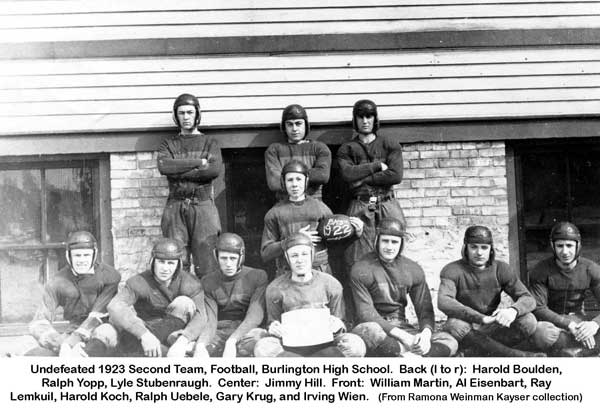 |
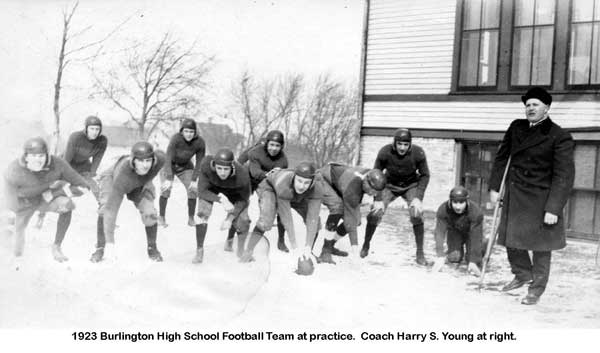
|
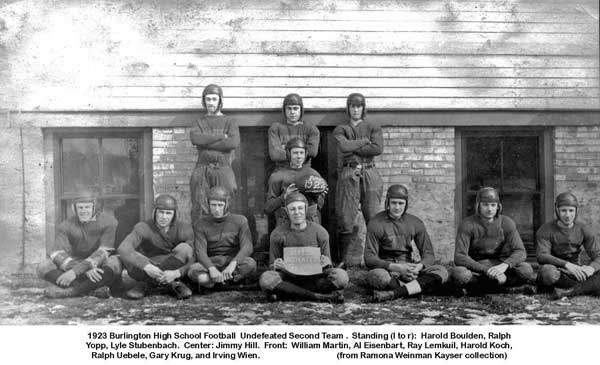 |
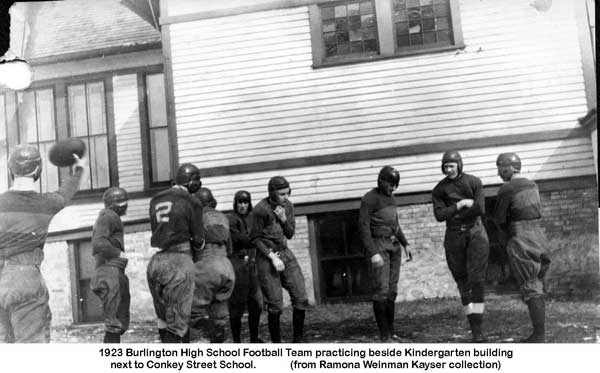
|
 |
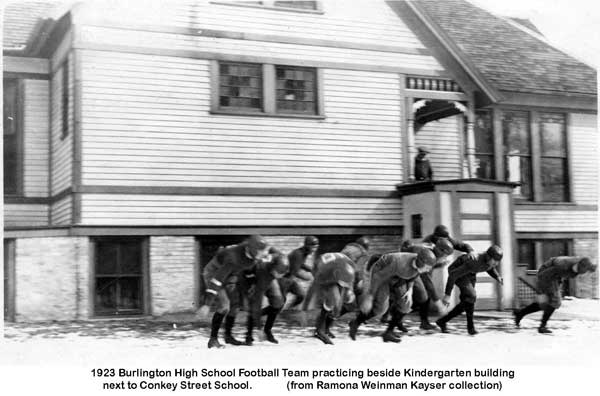
|
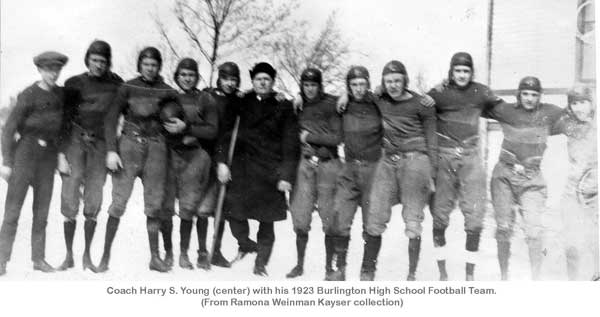 |
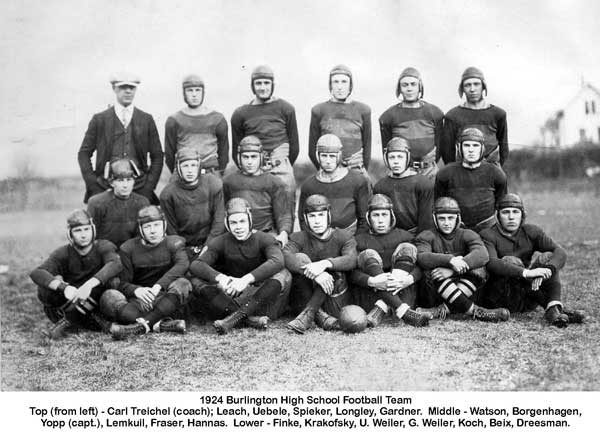 |
 |
Notices: Disclaimer and Restriction of Liability
Send mail to
webmaster@burlingtonhistory.org with questions or
comments about this web site.
Burlington Historical Society
Last modified: 02/01/09